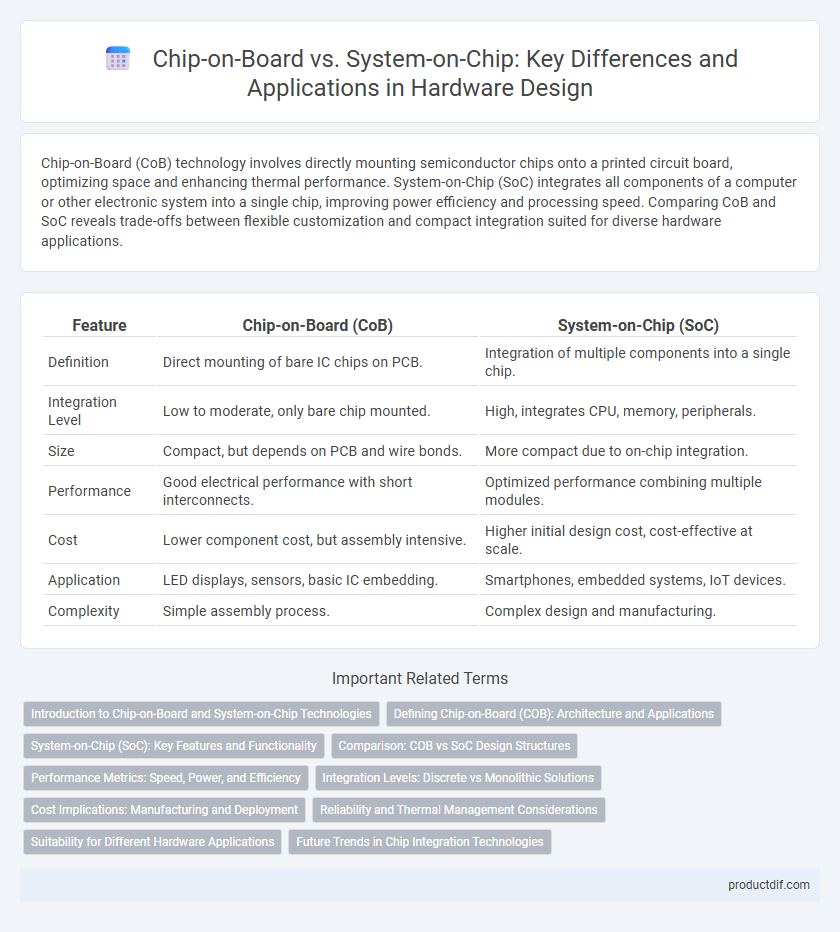Chip-on-Board (CoB) technology involves directly mounting semiconductor chips onto a printed circuit board, optimizing space and enhancing thermal performance. System-on-Chip (SoC) integrates all components of a computer or other electronic system into a single chip, improving power efficiency and processing speed. Comparing CoB and SoC reveals trade-offs between flexible customization and compact integration suited for diverse hardware applications.
Table of Comparison
| Feature | Chip-on-Board (CoB) | System-on-Chip (SoC) |
|---|---|---|
| Definition | Direct mounting of bare IC chips on PCB. | Integration of multiple components into a single chip. |
| Integration Level | Low to moderate, only bare chip mounted. | High, integrates CPU, memory, peripherals. |
| Size | Compact, but depends on PCB and wire bonds. | More compact due to on-chip integration. |
| Performance | Good electrical performance with short interconnects. | Optimized performance combining multiple modules. |
| Cost | Lower component cost, but assembly intensive. | Higher initial design cost, cost-effective at scale. |
| Application | LED displays, sensors, basic IC embedding. | Smartphones, embedded systems, IoT devices. |
| Complexity | Simple assembly process. | Complex design and manufacturing. |
Introduction to Chip-on-Board and System-on-Chip Technologies
Chip-on-Board (CoB) technology involves mounting bare semiconductor chips directly onto a printed circuit board, enabling compact and high-performance electronic assemblies by reducing interconnect lengths and enhancing electrical characteristics. System-on-Chip (SoC) integrates multiple functional components such as CPU, memory, and peripherals onto a single silicon chip, providing comprehensive system functionality and power efficiency tailored for mobile and embedded applications. Both technologies optimize space and performance but differ fundamentally in integration scope and design complexity, with CoB focusing on packaging techniques and SoC emphasizing integrated circuit design.
Defining Chip-on-Board (COB): Architecture and Applications
Chip-on-Board (COB) technology involves directly mounting bare semiconductor chips onto a printed circuit board (PCB) to optimize space and enhance electrical performance. This architecture minimizes interconnect lengths by eliminating traditional packaging, improving signal integrity and thermal dissipation for applications in compact electronic devices and high-frequency circuits. COB is widely used in automotive sensors, LED modules, and wearable technology where miniaturization and reliability are critical.
System-on-Chip (SoC): Key Features and Functionality
System-on-Chip (SoC) integrates multiple components such as CPU, GPU, memory, and input/output interfaces onto a single silicon chip, enhancing performance and energy efficiency. SoCs enable compact device designs by consolidating functionalities that traditionally required separate chips, supporting applications in smartphones, IoT devices, and embedded systems. Advanced SoCs often incorporate AI accelerators and security modules, providing versatile and scalable solutions for modern hardware demands.
Comparison: COB vs SoC Design Structures
Chip-on-Board (COB) design involves directly mounting bare semiconductor chips onto a printed circuit board (PCB) and encapsulating them with protective epoxy, optimizing space and reducing interconnect length for improved electrical performance. In contrast, System-on-Chip (SoC) integrates multiple components--such as CPU, memory, and peripherals--into a single silicon die, enhancing processing power and reducing overall system complexity. While COB emphasizes compact packaging at the board level, SoC focuses on semiconductor-level integration, enabling advanced functionalities and lower power consumption within embedded systems.
Performance Metrics: Speed, Power, and Efficiency
Chip-on-Board (CoB) technology offers superior thermal management and signal integrity, resulting in higher speed performance for demanding applications. System-on-Chip (SoC) solutions excel in power efficiency and integration by consolidating multiple components, reducing overall power consumption while maintaining balanced performance. Evaluating speed, power, and efficiency, SoCs provide optimized energy usage with moderate speed, whereas CoB designs prioritize maximum speed and signal quality at the cost of higher power usage.
Integration Levels: Discrete vs Monolithic Solutions
Chip-on-Board (CoB) integrates multiple semiconductor dies directly onto a single substrate, offering a discrete yet compact solution that enhances performance through reduced interconnect lengths. System-on-Chip (SoC) incorporates all necessary components, including CPU, memory, and peripherals, into a monolithic silicon die, achieving higher integration and power efficiency. The discrete nature of CoB allows customization and flexibility, whereas SoC delivers streamlined functionality within a unified architecture for complex, space-constrained applications.
Cost Implications: Manufacturing and Deployment
Chip-on-Board (CoB) technology offers lower upfront manufacturing costs due to simpler assembly processes and reduced packaging requirements, benefiting small to medium production runs. System-on-Chip (SoC) integrates multiple components into a single silicon die, significantly lowering long-term deployment expenses by reducing board space and improving energy efficiency, essential for high-volume applications. Cost efficiency in CoB is driven by flexibility and quick prototyping, whereas SoC achieves savings through economies of scale and enhanced system integration.
Reliability and Thermal Management Considerations
Chip-on-Board (CoB) technology offers enhanced reliability through direct wire bonding of bare silicon dies to a substrate, reducing interconnect failures common in packaged chips. System-on-Chip (SoC) designs integrate multiple components into a single chip, improving thermal performance by minimizing the parasitic thermal resistance associated with multi-chip modules. Effective thermal management in CoB systems requires advanced heat dissipation solutions due to higher power densities, while SoCs often benefit from optimized package designs that facilitate uniform heat distribution.
Suitability for Different Hardware Applications
Chip-on-Board (CoB) suits applications requiring compact, high-density integration with straightforward circuitry, offering excellent thermal management for LED drivers and sensor interfaces. System-on-Chip (SoC) excels in complex systems demanding integrated processing, memory, and peripherals, ideal for smartphones, IoT devices, and embedded systems. CoB provides cost-effective custom solutions for specialized hardware, while SoC supports versatile, high-performance computing needs across diverse technology sectors.
Future Trends in Chip Integration Technologies
Future trends in chip integration technologies emphasize enhanced miniaturization and performance, with System-on-Chip (SoC) designs advancing toward greater multifunctionality by integrating CPU, GPU, and memory on a single die, reducing latency and power consumption. Chip-on-Board (CoB) technology evolves to support higher I/O density and improved thermal management by directly bonding multiple dies onto a substrate, enabling more compact and efficient package solutions. Emerging 3D stacking and heterogeneous integration techniques combine SoC and CoB advantages, driving innovations in IoT devices, automotive electronics, and AI hardware with superior scalability and customization.
Chip-on-Board vs System-on-Chip Infographic

 productdif.com
productdif.com